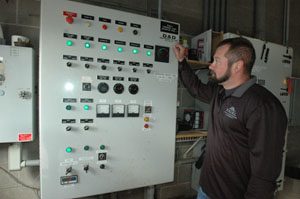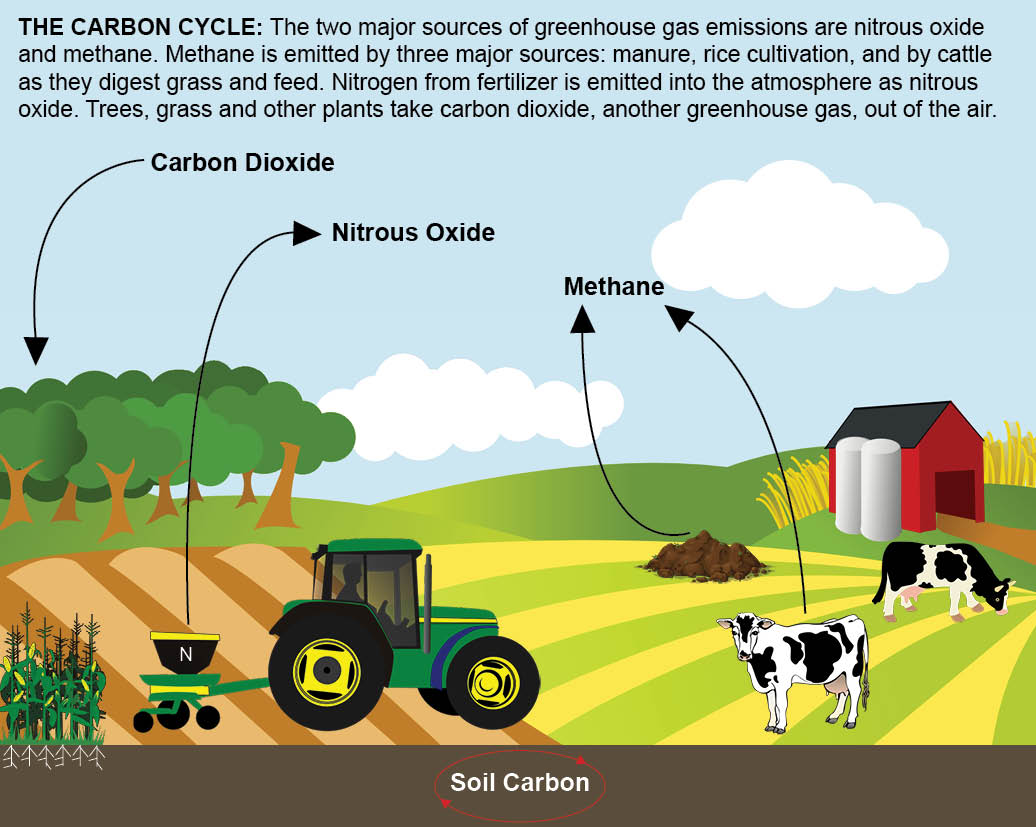This is the fourth part of our series, “Agriculture’s sustainable future: Feeding more while using less.” The third article looked at the prospects for farmers to get paid for practices and projects that sequester carbon or reduce their greenhouse gas emissions.
With farmers under pressure to cut their environmental footprint, global agribusiness giants as well as small tech startups are rushing to come up with ways to slash farm pollutants and make it possible for producers to cash in on carbon credits and other new forms of income.
These potential technological solutions include seed and soil treatments that can reduce the need for synthetic fertilizer or capture carbon from the air and store it in the soil. Feed additives can reduce the greenhouse gas emissions from belching cattle.
New forms of farming equipment could make it easier for growers to more precisely apply nitrogen fertilizer and other inputs — in other words, make precision agriculture more precise.
Vertical farming makes it possible to grow vegetables and puts leafy green growers closer to consumers and with less need for land.
Some of the technology solutions, such as the methane digesters that capture the biogas from livestock manure, already are being widely deployed. But digesters and nearly all of the tech fixes face barriers of some kind, economic or regulatory. And the jury is still out on how much impact some of the tools can have on greenhouse gas emissions and whether they can be both effective and make economic sense.
Most of the tech fixes are aimed at addressing in some way U.S. agriculture’s two major sources of greenhouse gas emissions: Nitrous oxide, a gas formed when nitrogen is applied to crops, and methane, which comes from livestock and rice cultivation. Together the two gases account for more than 98% of ag’s carbon footprint, according to the Environmental Protection Agency.
Products such as one produced by Pivot Bio, a startup based in Berkeley, Calif., that can help crops fix, or capture, their own nitrogen, are potential game changers because of the effect they would have on the greenhouse gas emissions of animal feed, according to Marty Matlock, executive director of the University of Arkansas Resiliency Center and a professor of ecological engineering who advises sustainability programs for numerous farm commodities.

Marty Matlock, University of Arkansas
It may take a while to perfect the products, but feed accounts for such a large part of the carbon footprint of hogs, chickens and turkeys that corn capable of fixing its own nitrogen could lower the greenhouse gas emissions of pork and poultry by 30%, he said.
“I have a bachelor's degree in agronomy that I finished in 1984, and we were talking about nitrogen-fixing corn back then. And it was a pipe dream that most of us thought would never occur in our lifetimes,” Matlock said.
Here is a look at some of the major technologies under development:
BIOLOGICALS
Benefits: Cut nitrous oxide emissions by reducing the amount of nitrogen fertilizer that plants require or by increasing soil carbon levels.
Prospects: Farmers who have tried them say they can reduce fertilizer usage while making them eligible for payments through emerging carbon markets.
Challenges: It’s still early in the deployment of the products to know how much they will affect fertilizer applications and farm economics. Carbon markets are still in development as well.
A big part of the answer to the question of whether farms will be able to address climate change can be found in the soil, where companies are focusing their efforts through the use of microbes to help plants fix and absorb nitrogen.
Two companies that are already selling products to farmers are Pivot Bio and Locus Ag Solutions, whose microbes, according to their own and university trials, have been able to increase yields and reduce the amount of nitrogen fertilizer growers have to apply.
Alex Fotsch, Locus AG’s vice president of agricultural operations, says “early indications suggest” corn growers who used its Rhizolizer product this growing season are on track to achieve yield increases of 9 to12 bushels an acre. With about half the data in hand, Fotsch said “increases in nitrogen and phosphorus uptake are also consistent and significant, and support what we have seen in the past.”
The company also is having success in orange groves in Florida, where about 15% of the citrus market and eight of the top 10 operations in the state are using Rhizolizer to help trees stave off the impacts of citrus greening, a disease that has devastated the state’s orchards.
Pivot Bio doesn’t have all its results back for 2020, but agronomy director Dan Poston said customer samples from this year showed more nitrogen was making its way into the corn. “We ended up with about 17 pounds more nitrogen per acre in the plant at about 70% of the locations that were sampled,” he said. “So that's pretty significant — it tells you that the microbe was doing its job in helping the plant secure more nitrogen in the above-ground plant mass.”
In 2019, corn yields from fields with Pivot Bio PROVEN were about 6 bushels an acre higher in on-farm and university trials than those with only synthetic nitrogen fertilizer.
“Increased plant growth, increased above ground plant nitrogen, and reduced firing of leaves below the ear were also observed,” the company said in an update.
Meanwhile, research is continuing at Joyn Bio, a joint venture between Gingko BioWorks and Bayer that is working to genetically engineer a nitrogen-fixing microbe that the company hopes can eventually reduce the need for nitrogen fertilizer by up to 50%.
“Most people don't really believe that you can engineer a plant to fix nitrogen, whereas we already know that there are microbes out there that can fix nitrogen and transfer it to plants, like soybeans,” says Joyn Bio CEO Mike Miille.

Mike Miille, Joyn Bio
Miille says the nitrogen reduction target to demonstrate “proof of concept” of its microbe next summer is in the 10% to 20% range. “Then you sort of optimize from there. We believe, based on what we've seen, that 40% is achievable, and possibly even higher,” he says.
Growers generally won’t adopt new technology solely because it’s good for the environment, Miille says. “Yes, they want to be sustainable, and yes they care about climate change and the environment. But you rarely can sell them on a product solely on that.”
However, once you can tell them they can reduce their nitrogen use by 25% to 30%, “it gets really interesting to them economically,” he says.
Pivot Bio’s nitrogen-fixing microbe product has sold out each of the past two growing seasons and the company has expanded capacity in the hopes of covering millions of corn acres in 2021, Poston says.
The company picked up $100 million this spring from investors including Breakthrough Energy Ventures — whose backers include Bill Gates and Jeff Bezos — which it is using to expand internationally, making the product available in Argentina and conducting trials in Canada. It is also moving towards commercialization of a new product for U.S. wheat.
“We have a lot of folks that are interested in our product, and a lot of folks, quite frankly, that really want us to be successful,” Poston said.
“The ultimate goal of our company is to replace synthetic nitrogen, if at all possible. How long it will take to get there, I can't tell you,” Poston said, adding, “We’ve certainly made the first viable step in that direction.”
Poston acknowledges that biologicals have a checkered history. Some products have had limited success, while others “are real failures.”
Locus AG also expresses optimism about its results. Rhizolizer was used on tens of thousands of acres this past growing season and expects to increase its presence in the Midwest in 2021.
Rhizolizer is mixed with a starter blend of micronutrients and applied through irrigation systems and makes it easier for plants to take up nutrients, the company says. In citrus, for example, the company reported a 73% average increase in root mass. In soybeans, it reported a 4 to 5 bushel an acre increase.
The company also claims significant reductions in emissions of nitrous oxide (75% to 85%), citrus (87%) and potatoes (60%). As a greenhouse gas, nitrous oxide is 300 times more potent as a greenhouse gas than CO2.
Meanwhile, Locus has created a program called CarbonNOW to lead farmers through the process of obtaining carbon credits. One of the first to participate is Iowa grower Kelly Garrett, who has enrolled 3,300 acres in the program for an expected payment of about $103 an acre, or about $341,000, over five years.
However, the payments are based solely on existing farming practices and don’t account for yields and carbon sequestration due to his use of Rhizolizer. Use of that product is currently in the process of being validated as a conservation practice, said a Locus spokeswoman.
So far, 5,000 of his credits have been sold, to Shopify, for $75,000. The rest are for sale in the Nori marketplace.
Pivot has used farmer customers to give testimonials to other growers.
During the 2020 Commodity Classic in San Antonio, Texas, Illinois corn grower Bryan Tomm said during 2019, an exceptionally wet year, he saw a 30% increase in yield compared to the standard practice of side-dressing rows with anhydrous ammonia.
Kevin Gerlach, an Iowa farmer, worries farmers could face restrictions on fertilizer. “If we don't do something on our own, they’re going to tell us what to do. And so we might as well be proactive and try something different … and this is the best thing I've found.”
Innovation in the biologicals space is being driven not just by goals to reduce greenhouse gas emissions in corporate supply chains, but by the impact of the changing climate on farming, said Joyn Bio’s Miille.
“Agriculture has a responsibility to come up with innovations and ways to provide new solutions in a much shorter timeframe,” he said, noting that new seed traits or chemicals can take more than a decade to get to market.
Because of climate change, farmers face “a really uncertain future about what's going to hit them next,” Miille said. “There are going to be diseases and pest problems that spring up in new places. Agriculture is going to be challenged by how fast change is coming, and how fast you can come up with solutions to combat that.”
Seed traits also are a way to demonstrate resilience. Syngenta says its Agrisure Artesian corn hybrids contain “multiple genes for season-long drought protection” and consistently deliver higher yields than competitive products.
“These are pretty incredible,” says Warren Kruger, newly appointed head of North American Seeds Development at Syngenta, linking the performance of the hybrids to research Syngenta conducts under “managed-stress” environments.
In a presentation at the recent Syngenta Media Summit, Kruger said the challenge in a climate-changed world “is to create winning reliable genetics that are going to perform consistently, even though the conditions on the farm are constantly changing.”
At the same summit, Laura Potter, global head of Analytics & Data Sciences at Syngenta, talked about improved tools to measure plant performance under different conditions.
“As the satellite technology continues to improve, we get higher and higher resolution images,” she said. “And then the ability to have different kinds of spectral images coming in gives us the chance to be able to measure phenotypes at a larger and a deeper scale in ways that that we can't do right now.”
Joyn Bio is working on what Miille calls a “programmable platform” that would allow microbes to be engineered to address specific problems such as pests or nutrient deficiencies. He likens the microbes to a “chassis” that can carry a “cargo” such as an enzyme or protein that, for example, would allow the plant to fend off a specific pest.
“We're looking for a very small set of microbes out there that colonize a specific plant really well, is easy to engineer and has a nice safety profile,” he says. “Once we have those, that's where we think we can then have a platform where you sort of dial up what you want.”
Once a chassis has been registered, Miille said “the registration process should be much easier. This is where we actually believe that we could get the development cycle down to five to six years, or roughly half of what it is today” for chemicals or seed traits.
“You can start to imagine almost a plug-and-play platform where you can dial up a solution,” he said. “The dream would be that we could engineer a microbe that could both capture and keep CO2 in the soil and at the same time increase the yield of the crop.”
METHANE DIGESTERS
Benefits: Significantly reduce methane emissions from livestock operations, replacing some fossil fuel use. Reduce farm odor.
Prospects: Deployed on many large dairy operations, and now they’re being added to some swine operations.
Challenges: Equipment costs millions of dollars, and they require access to a lot of manure to make them cost-effective.
Driven in part by climate change regulations enacted in California, the installation of methane digesters on dairy and swine operations is a booming business. The biogas the systems capture from manure can then be used as renewable natural gas to power homes and businesses as well as vehicles.
Dana Kirk, an assistant professor of engineering at Michigan State and manager of the Anaerobic Digester Research and Education Center, says interest in digesters is as high as he’s seen in his 20 years of work on the subject, and says he’d be surprised if “any dairy farmer of size, if they hadn't had five or six people visit them already to try and talk them into building a digester.”
“You literally have people just driving around the countryside and looking for farms,” he says, recounting a story from a dairyman who had just been visited by a confused-looking salesman who “walked in and handed them a brochure on, you know, digester company XYZ.”
The process, which can be accomplished in a variety of ways, involves storing the manure in an airtight vessel and allowing microorganisms to break it down, producing biogas that can be turned into compressed natural gas and a manure product solid enough to be spread on farmland.
Bryan Pagel, who manages a family farm with 5,000 cows near Kewaunee, Wis., says the system provides multiple benefits. The biogas is compressed into renewable natural gas and sold to a regional utility, DTE Energy.
The solids that are left after the liquid is removed for fertilizer are turned into bedding for the cows by running the material through a series of driers, large rotating cylinders, in which all the bacteria are killed. The bedding can be reused repeatedly and saves the farm money. “The cows love to lay on it. It’s like a giant pillow,” he said.

Bryan Pagel with the control panel for his digester equipment.
The liquid manure is pumped into lagoons and later spread on fields. Some is traded to neighbors for their corn for feed.
The digester also nearly eliminates the farm’s manure odor, a side benefit which can make livestock operations easier on neighbors.
The system cost the Pagel operation $9 million to $10 million, but a combination of government grants, including funding from USDA’s Environmental Quality Incentives Program and Rural Energy for American Program, cut the cost in half.
There are 263 digesters currently in operation in the U.S., according to EPA’s AgStar database. Most — 207 — are at dairy operations, though there has been more interest recently in using digesters at swine or poultry operations.
Interested in more coverage and insights? Receive a free month of Agri-Pulse.
Thirty-seven swine digesters are listed in the EPA database, including three completed this year. Of 19 digesters nationwide listed as currently under construction, according to EPA, six are swine operations, including one combined swine/poultry digester.
Meatpacking giant Smithfield Foods is now promising to make its company-owned hog operations carbon neutral in 2030, partly by converting manure gas into RNG.
One of its customers is Dominion Energy, a major East Coast utility. Smithfield, which estimates that emissions from hog manure account for 40% to 45% of the company’s emissions, says that nearly all of its finishing operations in North Carolina, Utah, Virginia and Missouri will have RNG projects by 2028.
California, which has 34 digesters in operation, has done a lot to spur the livestock industry’s interest. The state has legislated a 40% reduction in manure methane emissions by 2030 from its approximately 1.7 million dairy cows. In order to get there, it has given grants totaling more than $183 million for dairies to build 108 digesters, according to a report from CoBank earlier this year.
The state also has incentivized the use of renewable natural gas through its Low Carbon Fuel Standard, whose goal is to reduce the carbon intensity of transportation fuels in the state and which has created a credit compliance market.
Fuels in the California transportation fuel pool with a carbon intensity lower than the target established by the California Air Resources Board generate LCFS credits; fuels with higher carbon intensity may need to buy credits to comply with the standard.
“Biogas from dairy manure, swine manure has the lowest carbon intensity score by an order of magnitude compared to any other fuel out there,” says Kirk, which can make even smaller projects financially attractive.
“If a project can sell into the California Transportation LCFS market, qualifies for carbon credits, and (Renewable Identification Numbers) as part of the Renewable Fuels Standard it can be quite profitable,” says Mark Stoermann, chief operating officer at Newtrient, referring to all the credits available for renewable natural gas.
Newtrient was founded by 12 dairy cooperatives to “help farmers, technology providers, manure-based product developers and other stakeholders assess manure related challenges and opportunities.”
Given the current market prices, Stoermann says he wants to make sure dairy farms are treated fairly when a salesman knocks on their door.
“Sometimes the farmers don't understand what the real opportunity is,” he says. “There's nothing wrong with somebody who's going to bring in a lot of capital getting a good return, but there comes a point when they need to share that back with the dairy,” he says.

Mark Stoermann, Newtrient
Looking at current prices, Stoermann says a cow producing 20 or so MBTUs a year would be worth about $1,600, but “we sometimes see dairies being offered less than $100 for a cow. That may be fine as a starting point. But it seems to us that if you're building a $10 to $15 million project next to a $10 to $15 million dollar dairy, that once you've covered your project costs and profitability, you should probably share more than 10% of that opportunity.”
Markets for low-carbon fuel are spreading. “You've had Oregon follow suit, I think Washington State is close to following suit with some kind of carbon mitigation policy,” Kirk says. “So there's a trend out on the West Coast that's creating a nice stable platform for investment.”
In addition, the CoBank report notes that more than a dozen states have adopted clean car standards, “suggesting broader LCFS adoption.”
Digesters also got a big endorsement recently in a report from the Food and Agriculture Climate Alliance, whose co-chairs include leaders from the American Farm Bureau Federation, Environmental Defense Fund, National Council of Farmer Cooperatives and National Farmers Union.
In a series of policy recommendations, the alliance said digesters should be incentivized through a transferable production tax credit. Its report also called for “support for the Agriculture Environmental Stewardship Act, introduced by Sens. Sherrod Brown, D-Ohio, and Pat Roberts, R-Kan.” The bill would make digester systems eligible for a 30% investment tax credit to offset upfront installation costs.
Some critics object to subsidizing the digesters, arguing that they primarily benefit very large farming operations. “These types of manure-to-energy schemes are a false solution to the climate impacts of this industry,” says Tarah Heinzen, an attorney with Food and Water Watch. “Putting scarce public resources behind these technologies is going to only serve to entrench the factory farm industry and the natural gas industry.”
She believes the money would be better spent on “truly renewable sources of energy,” such as solar and wind, and “truly sustainable forms of agriculture.”
Solar and wind energy sources currently receive their own tax incentives, but they are being phased out and a political fight is brewing over extending them.
While digesters generally make sense only for larger operations, a Vermont program enables farms with as few as 250 cows to make money off digesters by selling electricity for nearly 20 cents a kilowatt hour, said Stoermann.
Stoermann also says that while anaerobic digestion “is not the perfect solution that some people say it is, it is a step in the right direction” for addressing climate change. “Because the methane never enters the atmosphere and the carbon dioxide from the fossil fuel never enters the atmosphere, it reduces GHG impact twice,” he said.
FEED ADDITIVES
Benefit: Reduce the amount of methane that cattle belch into the air. Cattle produce methane during digestion, a process known as enteric fermentation.
Prospects: It’s early, but some products show significant methane reductions
Challenges: It can take years to get FDA approval, and the agency doesn’t have an approval process for labeling feed additives as methane reducers.
Earlier this year, Burger King caused quite a stir when it aired a commercial that made some researchers on climate change and cows lose their lunch.
In a bizarre ad, a young singer dressed in a white cowboy outfit crooned about how Burger King had been “testing diets that would help reduce (cattle) farts.”
The solution, the guitar-slinging youngster and his fellow cowboys and cowgirls said, was lemongrass: “By now there ain’t no question that it’s helping cows’ digestion.”
But the fast-food giant left itself open to criticism. Researchers quickly jumped on Twitter to say that it’s the burps, not what comes out the other end, that are the problem. They also went after the company for what they called inadequate data to back up their claims that feeding a small amount of lemongrass to the animals reduced the impact of their flatulence by a third.
Whatever one may think of Burger King’s ad, the incident put the spotlight on the serious issue of methane emissions from cows and cattle, put feed additives in the news, and highlighted work by researchers worldwide to develop products that can reduce ruminant emissions.
“What they’re looking at with a fine-toothed comb is the efficacy of reducing enteric methane emissions,” says Juan Tricarico, vice president for sustainability research at Dairy Management Inc. and the Innovation Center for U.S. Dairy
But despite “good information on their efficacy or on their ability to reduce enteric methane,” Tricarico says many of those products are not available because they haven't received approval from FDA to make that claim on their labels.
Newtrient, which is funded by the dairy industry to assess research and advance the industry’s goal to achieve net-zero reductions by 2050, published a report earlier this year listing only three products on the market with “enteric methane implications”—AllTech’s YeaSacc, Syngenta’s Enogen, Agolin SA’s Agolin Ruminant — along with those available in the short term or that are in early-stage development.

Tim Bettington, Zoetis
Tricarico says he thinks it will be at least three years before there’s enough data for many of the products in the wings to be become widely available.
The pharmaceutical firm Zoetis believes that a product now on the market as a growth promoter, ractopamine, reduces air emissions from cattle. Zoetis has been working with the University of California-Davis on research that the company hopes to see published in the near future, said Tim Bettington, executive vice president and head of U.S. operations for Zoetis.
Zoetis would like to see FDA allow it to be labeled for the purpose of emission reductions, but FDA doesn’t have a process yet for doing that.
The regulatory barriers to feed additives received high-level attention from the new Food and Agriculture Climate Alliance, the coalition including major farm groups that recommended FDA expedite feed additive approvals, prioritizing those with “climate and digestive efficiency benefits.” The group said FDA ordinarily takes three to five year to review an animal feed ingredient.
“Feed additives are a promising tool to address enteric emissions in ruminants, and regulatory burdens are adding years onto the process of making these additives available to producers,” they said. “This lag in approval is likely also impacting research and development investments in this area in the United States.”
Of Enogen, the Newtrient report said, “When fed to dairy cows, reported data is encouraging with possible feed efficiency improvements of over 10%; however, more long-term studies are needed to substantiate claims.” Syngenta itself said recently Enogen improves feed efficiency by 5%.
Seaweed “is making great strides,” Tricarico said, but more research needs to be done and it faces the barrier of mass production. “It's got to be dry, it's got to have the shelf life.” Tricarico says.
“We have to create regenerative aquaculture systems to produce the seaweed,” said Dorn Cox, research director of Wolfe’s Neck Center in Maine, a nonprofit leading a collaborative effort including universities, government agencies, NGOs and corporations “to put the best locally-relevant agricultural knowledge into the hands of farmers to build healthy soil and capture carbon.”
Wolfe’s Neck is involved in research on how to reduce methane emissions from cattle by feeding them Maine seaweeds. Both Tricarico and Cox says the research on seaweed so far is “promising.”
A study released last year found that a red seaweed that grows in the tropics, when fed to lactating dairy cows, decreased methane emission by 80% and had no effect on feed intake or milk yield.
"We know that it is effective in the short term; we don't know if it's effective in the long term," said Alexander Hristov, a professor of dairy nutrition at Penn State. He said feed additives can lose their effectiveness as microbes adapt to them, so long-term studies will be needed .
Another promising product is Bovaer, developed by Dutch company DSM. A quarter teaspoon per cow per day “suppresses the enzyme that triggers methane production in a cow’s rumen,” DSM says. It’s expected to be available in Europe before making its way to the U.S., but it’s still undergoing trials.
The Newtrient report foresees Bovaer becoming available in 2024 in the U.S. after FDA approval. Over 35 trials have demonstrated it can reduce enteric fermentation by 30%. In the U.S., “it will still take multiple years to complete, given the long duration of several of the U.S. specific trials.”
Another product is Mootral, from Swiss company Mootral SA, a garlic and citric acid-based natural feed supplement. Tricarico, however, said while “citrus extracts or garlic extracts or oreganos get quite a bit of hype from the media, their evidence of efficacy in animals is nonexistent to minimal.”
The trick is to develop additives that can reduce enteric methane without harming the cow, Tricarico said. “The last thing we want to do is give the cows indigestion,” he said.
Worldwide, animal agriculture accounts for 14.5% of all greenhouse gas emissions, according to the United Nations’ Food and Agriculture Organization. In the U.S., however, cows and other ruminants make up about 4 percent of all GHGs, and beef cattle just 2% of direct emissions, according to University of California, Davis, professor and air quality expert Frank Mitloehner.
He says U.S. dairy operations represent 2% of GHGs. “Though the overall dairy contribution to U.S. GHG production is modest, enteric methane emissions (CH4), including gas produced by the cow’s digestive system and released by flatulence and burps, account for approximately 1/3 of a dairy farm’s GHG footprint,” says the Newtrient report, of which Mitloehner is an author.
“Believe it or not, nearly 60% of emissions created globally during milk production come in the form of enteric methane, released into the atmosphere burp by burp. A single dairy cow can generate three tons of CO2 equivalent every year,” says DSM, a Dutch company that has developed feed additives the company says will reduce a ruminant’s methane emissions by about 30%.
Researchers also are trying to breed more feed-efficient cows, but the genetic advances are likely still years away.
PRECISION AG
Benefit: Equipment that allows farmers to target inputs more precisely means they can use less fertilizer and chemicals.
Prospects: Improvements in the farm economy could encourage new equipment purchases.
Challenges: Cost, and in some cases inadequate internet access.
Much of the increase in productivity is likely to come from technology —the satellites, soil sensors, computer modeling and data-crunching that will provide usable information for growers.
“There’s a ton of technology that's embedded into accelerating the process of improving soil health,” says Dorn Cox of the Wolfe’s Neck Center, which is working with corporate, government and nonprofit partners to develop an Open Technology Ecosystem for Agricultural Management (OpenTEAM) that promises to provide farmers access to site-specific data by 2024.
“We're moving into essentially managing much more complex systems, especially in light of climate change,” says Cox. Much of what OpenTEAM is doing, he says, is trying to tie together all the different tools that are available, including artificial intelligence, remote sensing, lower-cost edge computing devices, and analytics.
“A lot of those pieces are there, but they haven't been connected into a coherent ecosystem that's useful for a researcher or producer,” he says.
Rates of adoption for precision agriculture vary widely by region, says Curt Blades, senior vice president for agriculture and forestry at the Association of Equipment Manufacturers, which is releasing a study early next year on the environmental benefits of precision agriculture.
Citing USDA data, he says yield monitors are being used by 69% of growers, and auto-steer, which enables farmers to precisely navigate their fields, is being used about by two-thirds, though rates are higher when looking only at row crops.
Use of variable rate technology, allowing precision application of inputs, stands at about 41%, he said. “Where you really unlock the power of a yield monitor is when you tie it to a map” showing the conditions in a field, allowing growers to pinpoint which area might need more fertilizer or which might need more water, he says.
“All of those things would not be available if you didn’t have GPS technology,” he said. He emphasized the importance of rural broadband, which he calls “critical to the future of our country. It’s got to be wireless to the field to really take full advantage of some of this great technology.”
Just using auto-steer and ensuring the machine’s computer systems are all working together properly — or telematics — saves 6% on fuel, Blades says. In addition, the new generation of farm equipment is about 20% more fuel-efficient than the previous one, causing some farmers to tell Blades they upgraded their combines based on fuel efficiency alone.
Nathan Fields, vice president of production and sustainability at National Corn Growers Association, thinks over the next decade, growers will be looking more at optimizing input use as opposed to simply increasing yields.
“Optimization doesn't necessarily mean yield,” he said. “It could mean yield and profitability.” But that can mean taking a “multi-year, almost a decade-long approach. And that's really hard to do with cash rent. That's really hard to do with the capital cycles that growers have to operate under.”
New tools are coming down the pike all the time. Anticipating commercialization, AMVAC Chemical Corp. and Corteva Agriscience just announced completion of testing on AMVAC’s proprietary SIMPAS prescriptive application equipment, which “allows farmers to prescriptively apply multiple at-plant solutions,” the companies said.
SIMPAS equipment can apply multiple products in fields similar to the way a a printer dispenses ink from ink cartridges, the companies say. The system uses software to control the application rate of each product on every row at every location in the field.
Fields thinks adoption of precision ag equipment will increase as the ag economy improves. “I think growers are looking for more of a stable ag economy in the coming years,” which will spur adoption, he said. “That's what we saw in that commodity super-cycle from 2007 to 2012. You know, technology adoption just ran rampant those years.”
Precision ag also could yield benefits in animal health; protecting food animals from disease makes them more efficient and can be a significant way to reduce their carbon footprint, according to a study by McKinsey and Co.
One example of precision ag equipment in animal health is an intelligent ear tag developed by Smartbow, an Austrian company acquired by Zoetis in 2018. The tags allow a producer to monitor the amount of time dairy cows spend at the feed bunk or drinking water and that information allows the farmer to more quickly identify cattle that may be ill. "When they’re off their daily averages that’s then you know something is up with the animal," said Tim Bettington, executive vice president and head of U.S. operations for Zoetis.
But the smart tags face the same challenges that many other variations of precision ag have: They need high-speed internet service. "We’ve been very supportive of the government's rural broadband initiatives," Bettington said.
VERTICAL FARMING
Benefits: Requires less land, can reduce food waste while saving on transportation-related carbon emissions by growing greens and vegetables closer to market. Vertical farming isn’t necessarily even carbon neutral, although the climate impact can be offset by the use of solar or wind energy to power the LED lighting that replaces sunlight.
Prospects: Help fill consumer demand for locally produced foods, while avoiding some of the food safety risks associated with field-grown crops.
Challenges: Demand for energy, and buildings and equipment require considerable investment.
Vertical farming may not provide a big part of the answer to mitigating climate change, but it can be an adaptation strategy.
“I think they are part of the climate solution,” says Henry Gordon-Smith, founder and CEO of Agritecture, which advises clients on a wide range of urban and vertical farming projects. “I do believe they are pioneers of an aspect of sustainable agriculture.”
But Gordon-Smith also does not believe humanity will be able to avert the effects of a changing climate — longer and more widespread drought, wild swings in weather patterns, and more severe flooding, for example.
Interested in more coverage and insights? Receive a free month of Agri-Pulse.
“It’s my belief that we have about seven to 10 years to mitigate climate change and climate change disaster,” he says. “It's not my belief that we as human beings will mitigate that disaster. The future of vertical farming after that period is actually an adaptation strategy.”
As for vertical operations mitigating climate change, Gordon-Smith says if he were to guess in 10 years about 20% of the vertical farming companies will be leaders in sustainability and the others “will just be corporations taking advantage of the fact that consumers need certain products at a certain price, no matter what the weather is, and the supply chain has been threatened.”
“As climate change gets worse, more countries and farms will have to grow indoors, because the areas where we have abundance of affordable food based on the climate and the soil will become limited,” he predicts.
After energy, labor is the highest cost for the facilities, he says. Both those costs have been coming down, but there’s still a lot of potential to reduce energy usage.
“There are huge opportunities still to reduce the carbon footprint of these farms,” says Grant Vandenbussche, chief category officer at Fifth Season, a leafy greens vertical farm near Pittsburgh.
The market is growing. A recent research report from the firm IDTechEx predicts the global market for vertically-farmed produce will increase from $781 million in 2020 to $1.5 billion by 2030, a compound annual growth rate of 6.85%.
But questions about its potential to become carbon-neutral have been pushed aside because of the excitement around vertical farming, Gordon-Smith says. “A lot of the hype has been pushed by the technology companies and the operators themselves, but it blinds us” from asking deeper questions about sustainability. “There’s much more work that needs to be done,” he says.
There are operations that are pushing their climate credentials. Dream Harvest in Houston advertises itself as carbon-negative, because it only delivers locally and is powered by 100% Texas wind energy.
Another operator working to make his vertical farm carbon-neutral is Vandenbussche’s Fifth Season, located in a 60,000-square-foot industrial space, which was able to produce 500,000 pounds of leafy greens in its first year.
“I'm investing everything into this business because I believe it has the ability to shape a better climate, shape a better world for all of us,” says Vandenbussche. Robots inside the operation monitor and move the plants, and the company is optimizing energy use.
The key to making vertical farms sustainable is reducing energy consumption, particularly the lights and the air conditioning systems, he says. “The thing that is constraining many of these vertical farms is they were not designed to be energy efficient.”
Through a smart, microgrid system, his company is able to pay less by using energy during low-peak periods, and forgo energy use during peak periods.
“We don't have people scheduling and controlling our operations,” Vandenbussche says. “So at 3 a.m. our lights in some cases will automatically turn on because that's when energy is being used the least on the grid.”
Fifth Season’s greens are pesticide-free and the company says it uses 95% less water and 97% less land than conventional agriculture.
The variety of products grown is currently limited. Vertical farming at this point can only provide microgreens, leafy greens and herbs at a commercial level, Gordon-Smith says, but strawberries and tomatoes are on the way.
“Every year, there's more advanced technology which is allowing more variety, but it's not that fast,” Gordon-Smith says.
Urban farming, involving large greenhouses, can grow a wider variety of products, including melons, peppers, cucumbers and potatoes.
One company, BrightFarms, is growing lettuce, spinach, arugula and basil hydroponically in regional greenhouses and distributing the crops through Walmart and Kroger stores and other supermarkets in the East and Midwest.
“Greenhouses are incredible,” Gordon-Smith said. “There's really nothing you can't commercially grow in these facilities — it just depends on the climate and the scale.”
Epilogue: Ag giants promise to help farmers combat climate change
Some of the largest suppliers of farm inputs have made commitments to help farmers in the United States and globally to address climate change while the companies work to reduce their in-house environmental footprint.
Corteva Agriscience announced pledges this year to help farmers sustainably increase crop yields by 20% while reducing greenhouse gas emissions by 20% compared to what they are this year.
Corteva also set 2030 targets to improve soil health on 74 million acres globally and to reduce water consumption while increasing yields on 6.2 million acres of seed production and water-stressed land.
“We’ll provide tools and innovations to improve soil health to increase the capacity of crops to withstand weather variability, enhance air and water quality, and support thriving habitats,” the company says.
Meanwhile, rival Bayer set a goal of reducing greenhouse gas emissions by 30% in large agricultural markets. “This is to be achieved by focusing on the most emissions-intensive forms of cultivation in the regions where the company operates,” the company said.

Sara Place, Elanco
Elanco Animal Health’s goal is to make it possible for “57 million more people to access their annual nutritious protein needs.” That comes down to keeping more food animals healthy, which may sound simply self serving for an animal drug company. But it also happens to be one of the most cost-effective ways globally to reduce greenhouse gas emissions from agriculture, including to the study by McKinsey and Co.
The study estimated that improving animal health monitoring and illness prevention would prevent 411 million tons of greenhouse gas emissions at a cost of about $5 a ton. Southeast Asia and sub-Saharan Africa would especially benefit.
By comparison, expanding the use of methane digesters to capture biogas from manure would reduce greenhouse gas emissions by 260 million tons at a cost of $92 a ton, the study found.
“We’re essentially improving the production of protein by making the system more efficient and also reducing the resources and emissions required,” said Sara Place, Elanco’s chief sustainability officer.
Elanco acquired Bayer’s animal health business earlier this year, expanding the company’s global reach.
Next: What will U.S. competitors have to do to address environmental challenges? American farmers already face increasing competition from Brazil, which has expanded crop production by deforesting large sections of the Amazon.
For more news, go to Agri-Pulse.com.


